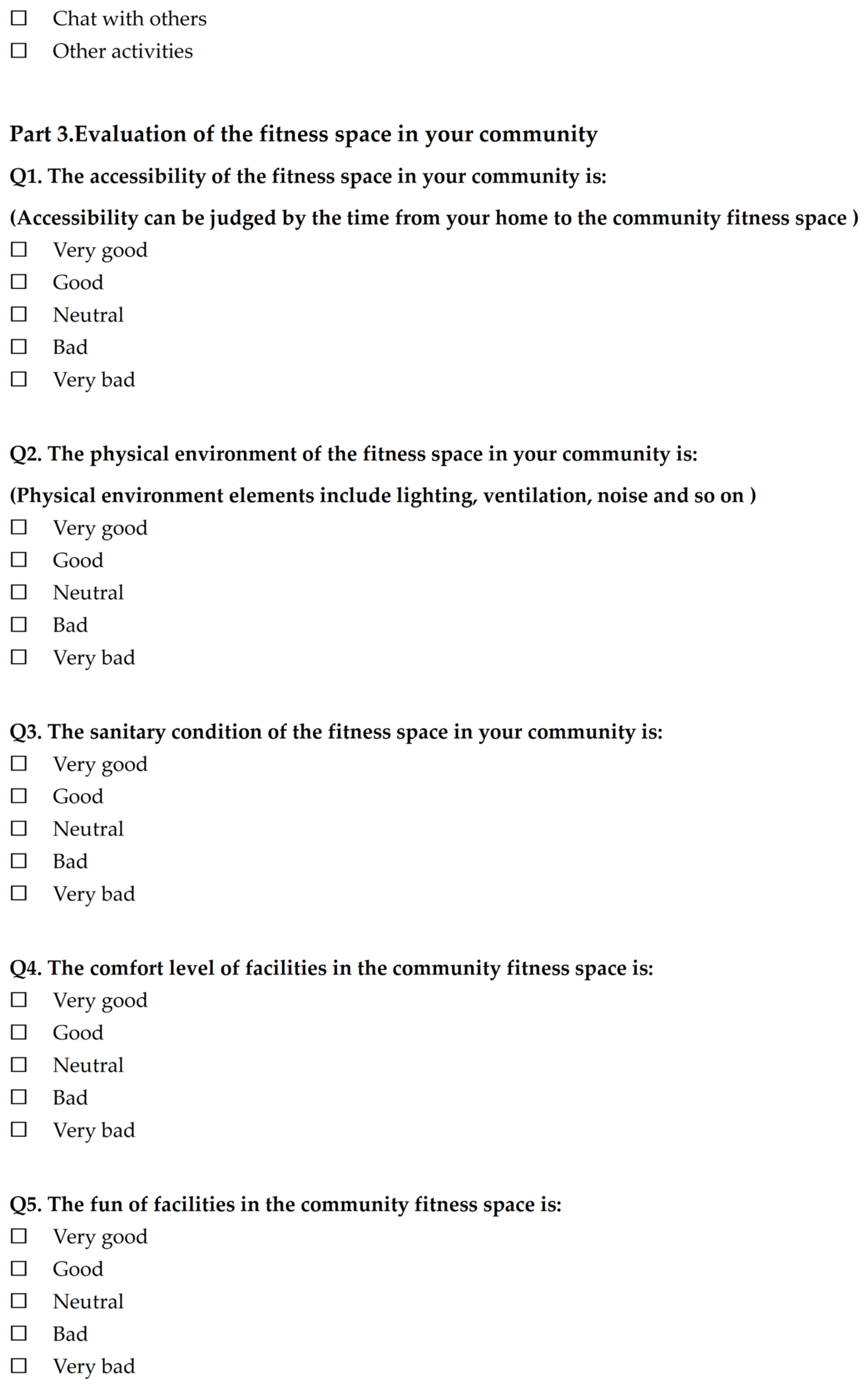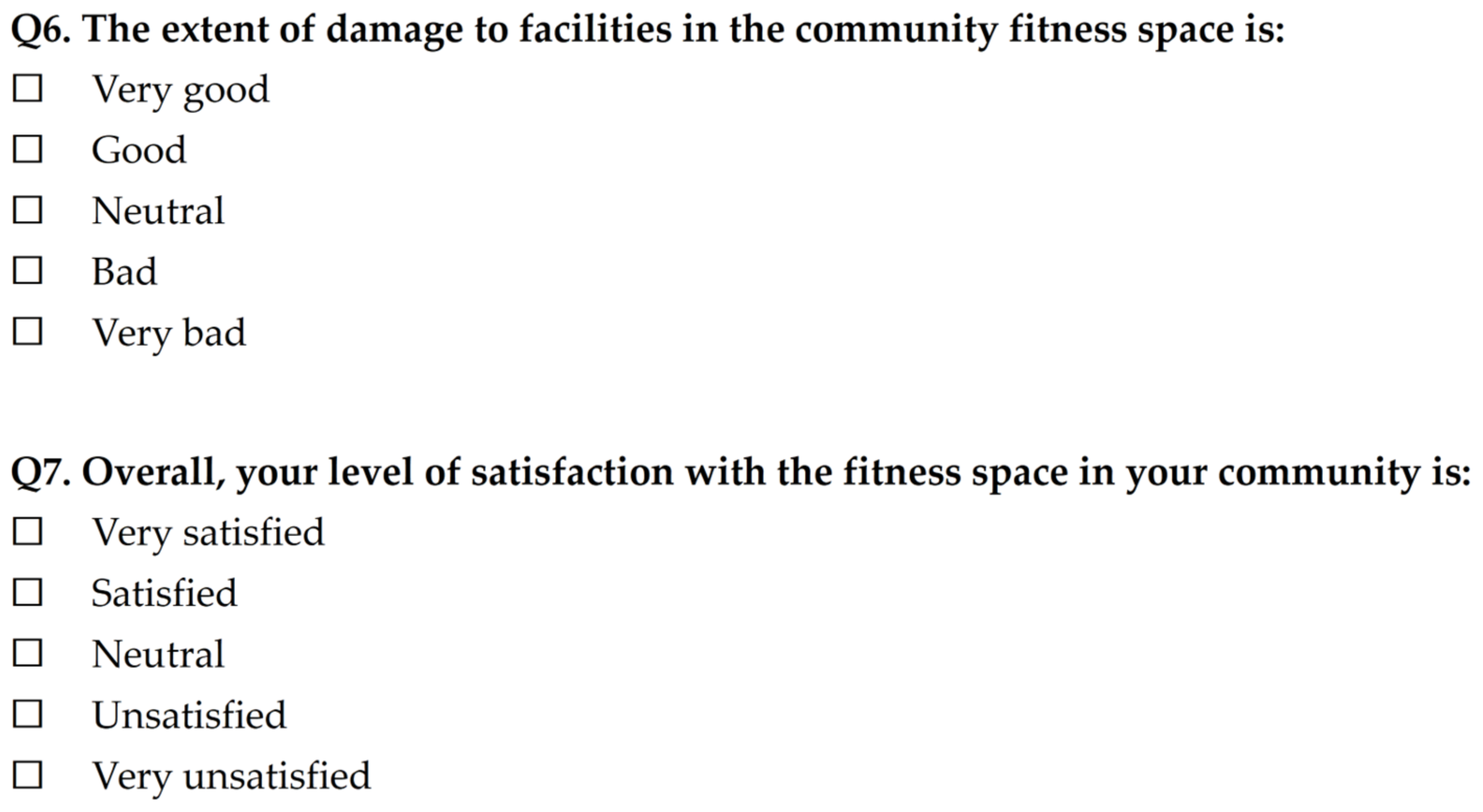1. Introduction
Non-communicable diseases (NCDs) are considered one of the two defining challenges of the 21st century, posing significant threats to health and sustainable development [
1]. According to the World Health Organization, 68 percent of global mortality is closely associated with NCDs [
2]. In China, this percentage is even higher and still shows a significant upward trend [
3]. Especially in first- and second-tier cities, the increasing prevalence of diseases such as dyslipidemia and fatty livers has seriously affected residents’ daily lives. And these diseases, originally targeting an older age group, have started to affect youngsters in recent years [
4].
Physical inactivity is one of the major causes of the rising morbidity of NCDs and accounts for approximately two million deaths per year [
5]. Thankfully, this situation can be effectively alleviated by creating attractive fitness spaces and encouraging residents to exercise [
6]. Consequently, the Chinese government issued a series of policies on exercise and health. A national plan called the National Fitness Program was first proposed in 1995, aiming to encourage more people to participate in physical exercise by improving the construction of public sports facilities [
7]. Then in 2016, “15-min fitness circle” was pointed out in the 13th Five-Year Plan to guarantee that public sports services were fully provided to all inhabitants [
4].
The promotion of these policies has led to an upsurge in the construction of outdoor fitness venues (parks, residential squares, and plazas). As a component of urban fitness systems as well as green infrastructure, these spaces play a key role in making cities healthy, resilient, and sustainable [
8].
Different from Europe and the United States, where residents’ outdoor exercise is mainly concentrated in urban public spaces such as city parks and fitness trails, China has developed a unique multi-level urban fitness system due to its large population and consumption patterns. It includes outdoor fitness spaces with a wide range of offerings, such as parks and trails, as well as small-scale fitness spaces that cater specifically to the interior of blocks or units. The community fitness space falls into the latter category.
Community fitness space refers to squares or open spaces where free fitness facilities are placed within communities [
9]. Since 1977, the Chinese government has invested CNY 1.05 billion in the construction of fitness facilities through sports lottery funds [
10]. As a result, a large number of community fitness spaces have emerged across the country. Due to their proximity to home, low cost, simple equipment operation, and flexible use, these spaces have become the preferred choice for many residents to engage in outdoor fitness activities, especially for the elderly [
11,
12]. However, their utilization is not ideal due to a lack of scientific planning. In some communities, fitness facilities are even left completely unused and merely serve as tools for drying clothes [
13]. Therefore, it is crucial to explore the factors that affect the use of such fitness spaces and provide references for their future planning, design, and management.
By reviewing international research on outdoor fitness spaces, we found that as early as 2004, Cavnar et al. established RFET, an evaluation system for fitness spaces [
14], to investigate the influence of built-environment factors on residents’ physical activities. In recent years, international research in this area has gradually matured, employing a variety of methods, both qualitative and quantitative [
15,
16,
17]. Some scholars have even begun to focus on specific groups, such as adolescents and the elderly [
18,
19,
20].
However, due to the differences in outdoor fitness systems between China and other countries, current international scholars still primarily focus on public outdoor fitness spaces such as urban parks, with very little attention devoted to small-scale fitness spaces. Although the relationship between built environment factors such as environmental quality [
21,
22], size of the site [
23,
24], service facilities [
15,
25], and users’ fitness behaviors has been examined in these public fitness spaces, their effects in the community fitness spaces still require further evidence, given the differences in spatial scale, scope of supply, and target users.
In China, from the proposal of the “National Fitness Program” to the construction of the “15-min Fitness Circle” [
26], the government has gradually strengthened its support for community fitness spaces in recent years. Consequently, an increasing number of Chinese scholars have shifted their research focus to this localized type of fitness space. For instance, in 2019, Chen Yujuan et al. found that road network density and urban population density were the main factors affecting the distribution of community sports facilities [
27]. In 2020, Wei Wei et al. explored the factors affecting the overall satisfaction of community sports facilities from perspectives such as spatial layout, function configuration, and service management [
28]. According to the above research, accessibility [
29], population density [
27], land development degree [
30], and other external factors have a certain effect on the distribution and usage of community fitness spaces.
Currently, most studies by Chinese scholars remain at the urban scale, analyzing the distribution of community fitness spaces and exploring factors from the perspective of whole-city planning. However, in addition to these external factors, ensuring the interior quality of the fitness venues is the final step to realizing their efficient operation. Few studies have focused on this point and identified the internal built-environment factors at micro and medium scales. To address this research gap, this study was conducted inside each community fitness space, exploring the influencing factors based on the characteristics of the space itself. As a supplement to the existing research, this work will make the evaluation system of community fitness spaces more comprehensive, thereby better guiding their future design and management.
5. Conclusions
Based on these findings, the following aspects should be emphasized in the planning and design of future community fitness spaces:
The inclusion of rest facilities should be fully considered in the design of the fitness space, aiming to provide an adequate number and variety of rest areas. In cases where the available area for fitness space is limited, utilizing the edges of flower beds or tree ponds to set up rest facilities can help ensure an adequate number of resting spaces. Additionally, the presence of plants can offer shade from the sun and protection from rain, enhancing the overall comfort of the fitness space.
The visible green index should be controlled at a suitable value in the design of community fitness spaces, and vegetation of different types, forms, and permeabilities could be carefully considered to separate and enclose space. As mentioned in previous studies, when the visible green index is controlled at 25% to 35%, it is most conducive to residents’ stays and activities in the fitness venue [
47].
The area of the fitness venues should be sufficient to meet the per capita indicator requirements. Additionally, try to make full use of the space so that it can undertake as many activities as possible.
Improving the quality of the physical environment of community fitness spaces is important, including full consideration of the orientation of the site and the distance between the site and high-rise buildings during the site selection stage, as well as choosing plants that can provide shade in summer or setting pools to locally regulate the temperature in these spaces.
Regularly checking the quality of community fitness facilities is necessary, especially those in communities with earlier construction years. Timely repairs or replacement of old and broken facilities can help ensure their comfort and safety.
By examining the associations between the aforementioned built environment factors and the utilization of community fitness spaces, this study has made a certain contribution to the quantitative exploration of these spaces at micro and medium scales, but it also has the following limitations:
- (a)
Although some objective indicators were introduced to measure and quantify the built environment, there were still some factors, such as the quality of fitness facilities, that were difficult to obtain by this method. These data were still collected using questionnaires. Despite the reliability and validity of questionnaires having been verified, the questionnaire data were still prone to deviation from reality based on users’ subjective impressions.
- (b)
To reduce the interference of other variables, the samples selected in the current experiment were in the same city and region, and the time of recording the utilization rates was also concentrated in the same season (summer). However, when the location and season change, whether the factors impacting the utilization rates and satisfaction levels of community fitness spaces will also change still needs to be verified by subsequent experiments.
- (c)
The measurement of greenery in this study only stays at the visual level, and its health effects on other aspects such as temperature and air quality have not been reflected. In the future, with the growth of cities, pollution, and poor air quality, residents’ demand for green space will increase. At that time, more significant than its aesthetic effect was its sustainable regulatory impact on its surroundings, even the whole city. Considering this, a more comprehensive and scientific method to measure greenery is needed, incorporating qualitative and quantitative indices on the availability of greenery. In addition, the surface area of green spaces in relation to air quality should also be taken into account at different times of the day, seasons, and periods.
With the vigorous implementation of the “National Fitness Program”, it is believed that in the future, community fitness spaces will occupy an increasingly important position in the urban fitness system. To make their role in improving residents’ health and achieving urban sustainability more fully realized, more comprehensive and in-depth studies are needed in the future, such as exploring the needs and usage of community fitness spaces by users of different ages and occupations and making the planning or renovation of future community fitness spaces more targeted based on the age and occupational structure of the corresponding community. In addition, future research should also pay more attention to comparative studies between different regions, such as the difference in distribution and demand for community fitness spaces between the north and south cities, or between urban and rural areas in the same region. By recording, comparing, and analyzing the fitness spaces of different cities on the same day, the influence of regional factors on fitness spaces can be explored to make the evaluation system of this type of space more comprehensive.






















